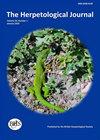Repeated use of high risk nesting areas in the European whip snake, Hierophis viridiflavus
IF 0.6
4区 生物学
Q3 ZOOLOGY
引用次数: 2
Abstract
Oviparous snakes deposit their egg clutches in sites sheltered from predation and from strong thermal and hydric fluctuations. Appropriate laying sites with optimum thermal and hydric conditions are generally scarce and are not necessarily localised in the home range. Thus, many gravid females undertake extensive trips for oviposition, and many may converge at the best egg laying sites. Dispersal mortality of neonates post-hatchling is also a critical factor. Assessing the parameters involved in this intergenerational trade-off is difficult however, and no study has succeeded in embracing all of them. Here we report data indicating that gravid females of the highly mobile European whip snake, Hierophis viridiflavus exhibit nest site fidelity whereby they repeatedly deposit their eggs in cavities under sealed roads over many decades. These anthropogenic structures provide benefits of relative safety and suitable incubation conditions (due to the protective asphalted layer?), but they expose both females and neonates to high risk of road mortality. Artificial laying sites constructed at appropriate distances from busy roads, along with artificial continuous well protected pathways (e.g. dense hedges) that connect risky laying sites to safer areas, should be constructed.欧洲鞭蛇Hieophis viridiflavus重复使用高风险筑巢区
卵生蛇把它们的卵窝产在躲避捕食者和强烈的热量和水分波动的地方。具有最佳热和水力条件的适当铺设地点通常很少,而且不一定在家庭范围内。因此,许多怀孕的雌性要长途跋涉去产卵,许多可能会聚集在最好的产卵地点。幼崽在孵化后的分散死亡率也是一个关键因素。然而,评估这种代际权衡所涉及的参数是困难的,而且没有一项研究成功地涵盖了所有这些参数。在这里,我们报告的数据表明,高度移动的欧洲鞭蛇(Hierophis viridiflavus)的怀孕雌性表现出筑巢地点的保密性,它们在数十年的时间里反复将卵产在封闭道路下的洞穴中。这些人为结构提供了相对安全和适宜孵化条件的好处(由于保护性沥青层?),但它们使雌性和新生儿暴露于道路死亡的高风险之中。应在离繁忙道路适当距离处建造人工铺设地点,并在连接危险铺设地点和较安全区域的连续人工保护通道(例如茂密的树篱)上建造。
本文章由计算机程序翻译,如有差异,请以英文原文为准。
求助全文
约1分钟内获得全文
求助全文
来源期刊

Herpetological Journal
生物-动物学
CiteScore
2.40
自引率
10.00%
发文量
25
审稿时长
>12 weeks
期刊介绍:
The Herpetological Journal is the Society''s prestigious quarterly scientific journal.
 求助内容:
求助内容: 应助结果提醒方式:
应助结果提醒方式:


